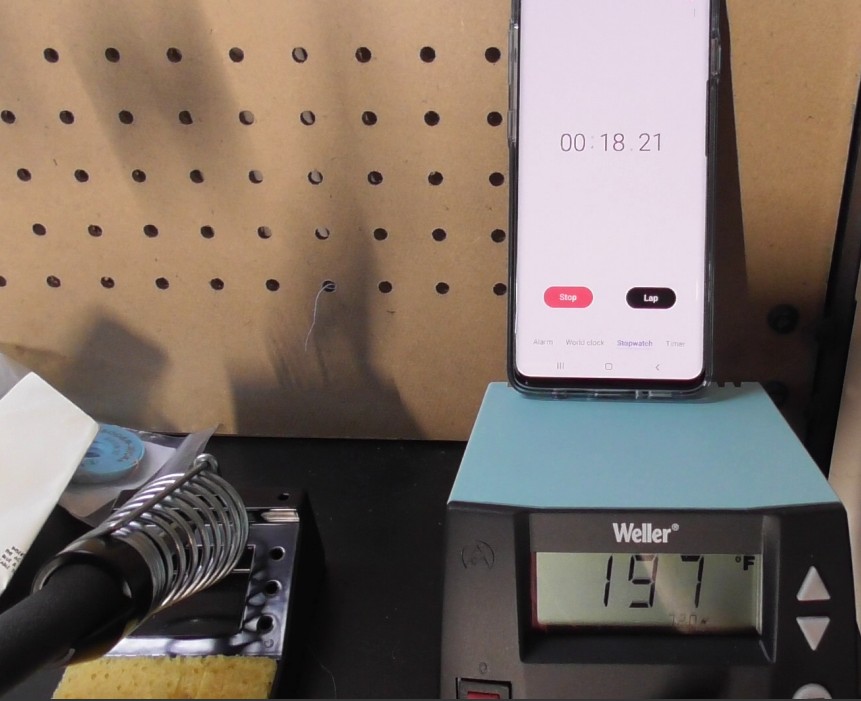
One Fast Soldering Iron
You should see how fast this Weller soldering iron heats up – watch!
I go through phases of work when I use a soldering iron a lot, and I have phases when the soldering iron goes untouched for a long time. I buy soldering irons like I buy cars: I do my homework before I buy, and when I buy one we’re together to the end. It’s a tool I rely on to be there and just do it’s job every single time I turn it on. Recently, it was time to replace my trusty iron.
What do I look for in a soldering iron? If you read through the DIY clock series, you know I do a lot of thinking before I do the buying. I have a few criteria for a soldering iron:
- It has to have a variety of tips available from a source that will be around for the next several years. You never know when you will some type of tip you don’t have for some project. That’s no time go hunting for a no-name supplier you bought from once five years ago.
- The tips have to be high-quality in terms of materials, tinnability, and temperature stability. Just as painting well with a bad brush is impossible, so is soldering well with a poor quality tip. It’s critical not to be limited in what you can do by a sub-par tool.
- It has to last. And last. And last. When you’re driving, you don’t want to wonder if your car will start or make the trip every time you use it. When you’re working, you don’t want to have to worry about whether or not your tools will back you up. Good stuff may cost a little more in the beginning, but it’s less expensive than buying multiple replacements for the same low-grade tool.
Soldering Irons Plus – Tempting?
Even with those criteria in my mind, I couldn’t resist looking at some of the multi-function stations that are out there. These 2-in-1 Soldering Iron Hot Air Rework Stations, 3-in-1 Iron/Air/DC Power Supply Stations, and even 4-in-1 Stations are tempting. To think that you could have a soldering iron, a hot air station for surface mount work, and even another DC bench supply, all for under $100 (except the 4-in-1 of course) is tempting. Even the ratings on Amazon weren’t too terrible for them. Some people had some infant mortality of devices failing in the first month or so, but plenty said they’ve been using it for years and it works fine, with a few eccentricities. I mulled this around for about a day, but I just couldn’t get comfortable with the idea.
With these stations, I’m concerned I might have to work on my soldering station to get it to work. I’m concerned I won’t be able to find tips for it in five years. I’m concerned it doesn’t say it’s UL Listed, which would help me believe the circuits within are designed reasonably safely. When something’s not UL listed, I suspect it’ll burst into flames when I’m not watching it. I know it costs money and time to get the UL listing, and not getting it can be a way to save money and keep your prices low. I also know it means a third-party never looked at your product and agreed that it’s safe to leave plugged into a wall outlet.
Quality Soldering Irons
So with all that in mind, I decided to narrow the field to two brands: Weller and Hakko. I’ve used them both for years. I trust them to work. I trust them to be around. If you’re like me and haven’t shopped for a new soldering iron for years, here are the current front-runners for personal/hobby/DIY use from Hakko and Weller.
They’re both around 70 Watts, they’re both simply soldering stations (1-in-1 if you will), and they’re both around $100. Their appearance is quite different. The last Hakko I had was black and gold as I recall. They’re now a playful yellow/blue two-tone. The Weller looks like, well, a Weller. The same colors and attitude it’s always had.
I ended up buying the Weller WE 1010. There’s not a lot to it on the outside, but I know it will meet all my criteria above. I started using it this week, and I’m very happy with it. It does exactly what it’s supposed to do, and I’m sure it will for years to come.
There was one pleasant surprise. I was very impressed with how quickly this iron heats up. The old analog irons don’t have gauges, so you have listen for the “pffft” on the sponge, and melt some solder on the tip to see if it’s up to operating temperature yet. The digital display on this station lets you know the temperature of the tip. You can see it go down and then recover when trying to heat up a large joint on a heat sink for example. The most impressive quality for me so far is how quickly it gets to operating temperature. Can it go from being overnight-in-the-shop cold to 720F in less than one minute? Watch the video below to find out!
The Best Soldering Iron
If you’re serious about electronics and looking for a soldering station, take my advice and get a good one. You’ll be able to do better work, you’ll have it for a long time, and although it may not seem like it up front, you’ll spend less in the end. Buy the Hakko or the Weller, not the one that tries to be all things to everyone. You’ll be glad you did.

